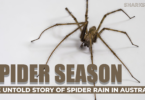Osprey, commonly known as “sea hawk” or “fish hawk” is a glorious bird that has captured the imagination and heart of wildlife lovers and bird enthusiasts. Their striking appearance, unique behavior, and incredible hunting prowess make them the most magnificent creatures that need our admiration and attention. This article will delve into the world of osprey and uncover more interesting and knowledgeable facts about their lifestyle.
What is the Scientific Classification of Osprey?
The Osprey is scientifically classified as:
- Kingdom: Animalia
- Phylum: Chordata
- Class: Aves
- Order: Accipitriformes
- Family: Pandionidae
- Genus: Pandion
- Species: haliaetus
What is the Range and Habitat of the Osprey?
Ospreys are widely adapted birds that live in a wide range of habitats. Since these settings offer them an abundance of food sources, they are frequently seen close to beaches, rivers, estuaries, bays, and reservoirs. During the mating season, these creatures are seen throughout North America, Asia, and Europe whereas in the non-breeding season, they move to Africa, Central America, and South America.
What is the Biology and Appearance of Osprey?
Osprey is a large bird that is known for its distinctive appearance, characterized by a white head with a dark eye stripe, a brownish-black back, and a white belly. They have a total body length of 2 feet and weigh around 4 pounds but have long and powerful wings that are 5.5 to 6 feet long, allowing the osprey to be well-adapted to their hunting lifestyle.
Ospreys have bright yellow eyes and keen eyesight which enable them to spot fish even from several hundred feet above. Their feet are equipped with spiny scales on the underside, which help them maintain a firm grip on slippery prey, marking them highly efficient hunters.
What are the Diet and Hunting Strategies of Osprey?
The diet of osprey exclusively consists of fish, making them the most specialized fish-eating raptors in the world. Ospreys have exceptional hunting abilities; they fly above the water and use their sharp vision to search the surface. When they see a fish, they plunge in headfirst and use their strong talons to capture it. Ospreys bring their caught fish back to their nest or a nearby perch with their talons to eat.
How Does the Breeding Process of Osprey Occur?
Due to their monogamous nature, ospreys frequently return to the same nesting location each year. The breeding season of ospreys is in the spring when males arrive at the nesting site to refurbish the nest to begin the courtship and display bonding rituals.
After successful mating, the female lays eggs that are usually 2 to 4 in number. Both parents look after the incubating eggs, which hatch approximately after 5 to 6 weeks, and provide them nourishment to stay healthy. The young become independent at about 7 to 8 weeks of age, however, they could still look to their parents for direction for a few weeks after leaving the nest.
What Behavior Does Osprey Exhibit?
The ospreys adopt various behaviors for survival as they communicate with each other via calls and vocalizations, which play a crucial role in mate attraction and territory defense. Ospreys embark on impressive migrations twice a year and are a testament to their endurance and navigational abilities.
What is the Conservation Status of Ospreys?
Ospreys are not currently considered endangered but on the red list of IUCN, they are classified as a species of “Least Concern”. However, these species faced significant challenges due to habitat loss, pollution, and the use of pesticides like DDT, leading to the decline of their population for many reasons. For their long-term survival, it is crucial to keep an eye on Osprey numbers and their habitats.
Interesting Facts About Ospreys
Some of the interesting facts about ospreys are:
- Ospreys are distributed globally except in Antarctica.
- Ospreys are called “fish hawks” due to their remarkable fishing skills.
- They are skilled divers and can dive from high heights into the sea to get their prey.
- In the wild, they may live for 15 to 20 years, and much longer in captivity.
- Osprey nests are called eyries, which can grow to massive sizes with time, as the birds continuously add sticks and materials to them.
Conclusion
The osprey is a captivating bird that has a striking appearance, unique adaptations, and remarkable hunting skills, undeniably mark them as the most captivating birds of prey in the avian world. Despite their well-adaptive behavior to various habitats, ospreys face significant survival challenges, therefore, it is necessary to implement conservation efforts to stabilize their populations, allowing them to continue soaring through our skies and gracing our waterways.







